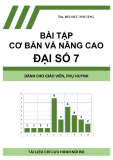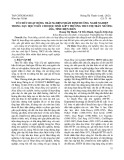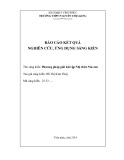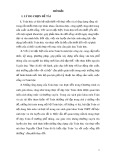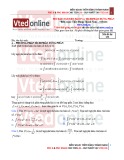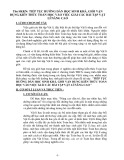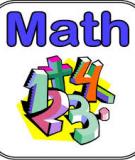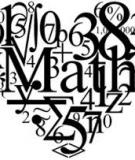Independence number of 2-factor-plus-triangles graphs
Jennifer Vandenbussche(cid:3) and Douglas B. Westy
Submitted: Jun 10, 2008; Accepted: Feb 18, 2009; Published: Feb 27, 2009 Mathematics Subject Classi(cid:12)cation: 05C69
Abstract
G
G
G
= 12) there is an n-vertex graph in
G
A 2-factor-plus-triangles graph is the union of two 2-regular graphs G1 and G2 with the same vertices, such that G2 consists of disjoint triangles. Let be the family of such graphs. These include the famous \cycle-plus-triangles" graphs shown to be 3-choosable by Fleischner and Stiebitz. The independence ratio of a graph in may be less than 1=3; but achieving the minimum value 1=4 requires each component to be isomorphic to the 12-vertex \Du{Ngo" graph. Nevertheless, G contains in(cid:12)nitely many connected graphs with independence ratio less than 4=15. For each odd g there are in(cid:12)nitely many connected graphs in such that G1 has girth g and the independence ratio of G is less than 1=3. Also, when 12 divides n (and n such that G1 has girth n=2 and G is not 3-colorable. Finally, unions of two graphs whose components have at most s vertices are s-choosable.
6
1 Introduction
(cid:3)Department of Mathematics, Southern Polytechnic State University, Marietta, GA 30060, jvan-
denb@spsu.edu
yDepartment of Mathematics, University of Illinois, Urbana, IL 61801, west@math.uiuc.edu. Research
partially supported by the National Security Agency under Award No. H98230-06-1-0065.
the electronic journal of combinatorics 16 (2009), #R27
1
The Cycle-Plus-Triangles Theorem of Fleischner and Stiebitz [5] states that if a graph G is the union of a spanning cycle and a 2-factor consisting of disjoint triangles, then G is 3-choosable, where a graph is k-choosable if for every assignment of lists of size k to the vertices, there is a proper coloring giving each vertex a color from its list. Sachs [8] proved by elementary methods that all such graphs are 3-colorable. Both results imply an earlier conjecture by Du, Hsu, and Hwang [1], stating that a cycle-plus-triangles graph with 3k vertices has independence number k. Erd}os [3] strengthened the conjecture to the more well-known statement that these graphs are 3-colorable. We return to the original topic of independence number but study it on a more general family of graphs.
x1; x2; x3g f A 2-factor-plus-triangles graph is a union of two 2-regular graphs G1 and G2 on the same vertex set, where the components of G2 are triangles. Note that G1 and G2 may share edges. For such a graph G, we denote the vertex sets of the components of G2 as , and we refer to Tx as a \triple" to distinguish it from T1; : : : ; Tk, with Tx = a 3-cycle in G1. When G1 is a single cycle, G is a cycle-plus-triangles graph. Let G that contain K4 (see Figure 1, for example), so graphs in G G
G
G
G
denote the family of 2-factor-plus-triangles graphs. It is easy to construct graphs need not be 3-colorable. in is 3-colorable whenever its factor G1 is C4-free. Fleischner Erdos [3] asked if a graph in that and Stiebitz [6] answered this negatively, citing an in(cid:12)nite family of such graphs in with 3k vertices may fail to have an are 4-critical, due to Gallai. In fact, graphs in independent set of size k, such as the graph in Figure 1 due to Du and Ngo [2]. Here we draw only G1 and indicate the triples Ta; Tb; Tc; Td using subscripted indices.
c1 (cid:15) d1 (cid:15) a3 (cid:15) c3 (cid:15) a1 (cid:15) b1 (cid:15)
(cid:15) b2 (cid:15) a2 (cid:15) d2 (cid:15) c2 (cid:15) d3 (cid:15) b3
Figure 1: The Du-Ngo graph GDN , omitting triangles on sets of the form
x1; x2; x3g . f An independent set is a set of pairwise nonadjacent vertices. The independence number
(cid:11)(G) of a graph G is the maximum size of such a set in G.
Proposition 1.1. The independence number of the Du-Ngo graph GDN is 3.
. Further, S contains two vertices of and
Proof. An independent set S in GDN contains at most one vertex from each of the 4-cliques c1; d1; c2; d2g a1; b1; a2; b2g only f f if it avoids one of the 4-cliques. Thus a3; b3; c3; d3g f achieves the bound. 3, and S j j (cid:20) a1; c1; d3g f
G
G
. We also construct in(cid:12)nitely many connected graphs in G
The independence ratio of an n-vertex graph G is (cid:11)(G)=n. Proposition 1.1 states that the independence ratio of GDN is 1=4. Because graphs in have maximum degree at most 4 and do not contain K5, Brooks’ Theorem implies that every graph in has independence ratio at least 1=4. We characterize the graphs achieving equality in this easy bound; they are those in which every component is GDN . We produce larger independent sets for all other graphs in G with independence ratio less than 4=15. However, we conjecture that for any t less than 4=15, only (cid:12)nitely many connected graphs in have independence ratio at most t. G In light of Erd}os’ question about 3-colorability of graphs in G
the electronic journal of combinatorics 16 (2009), #R27
2
when G1 has no 4- cycle, we study the independence ratio under girth restrictions for G1. For any odd g, we construct in(cid:12)nitely many connected examples in which the girth of G1 is g and yet
1
g2+2g when g
3 (cid:0)
(cid:17)
V (G) j j
the independence ratio is less than 1=3; it can be as small as 1 1 mod 6. The number of vertices in each example is more than g2, and we conjecture that the independence ratio of G is 1=3 when G1 has girth at least p V (G) . On the other j j can guarantee 3-colorability; when the number hand, no girth threshold less than of vertices is a nontrivial multiple of 12, we construct examples where G1 consists of just two cycles of equal length but G is not 3-colorable.
G
Finally, we show that if G is a union of two graphs whose components have at most s vertices, then G is s-choosable; this yields 3-choosability for graphs in where the components of G1 are all 3-cycles. This last result is an easy consequence of the s- choosability of the line graphs of bipartite graphs.
2
Our graphs have no multiple edges; when G1 and G2 share an edge, its vertices have degree less than 4 in the union. For a graph G and a vertex x V (G), the neighborhood NG(x) is the set of vertices adjacent to x in G, and a G-neighbor of x is an element If A and B are sets, then of NG(x). For S A V (G), we let NG(S) = Sx2S NG(x). B a B = (cid:0) f 2 (cid:18) A : a = 2 . g
2 Independence ratio at least 1=4
G
0 =
G G ) : G is connected ( G (cid:0) f 2 G f
2 G
The independence number of a graph is the sum of the independence numbers of its with independence ratio 1=4, it components. Therefore, to characterize the graphs in other than GDN has independence ratio su(cid:14)ces prove that every connected graph in GDN g larger than 1=4. Let . g Proving this is surprisingly di(cid:14)cult. We present an algorithm to produce a su(cid:14)ciently 0. A simple greedy algorithm (cid:12)nds an independent large independent set for any G set with almost 1=4 of the vertices; it will be applied to prove the full result. This simple algorithm maintains an independent set I and the set S of neighbors of I.
S = V (G), [ 6 S Algorithm 2.1. Given an independent set I in G, let S = NG(I). While I choose v S) to minimize V (G) (I N (v) j , and add v to I and NG(v) to S. j 2 (cid:0)
(n 1)=4. If G has an G (cid:21) (cid:0) > [ Lemma 2.2. If G is an n-vertex graph in I0j independent set I0 with 3 j (cid:0) 0, then (cid:11)(G) , then (cid:11)(G) > n=4. NG(I0) j j
[
+ S j I j j j Proof. Initialize Algorithm 2.1 with I as any single vertex in G; this puts at most 4 vertices in S. At each subsequent step, some vertex v outside I S has a neighbor in S, since G is connected and NG(I) = S. Hence each step adds at most 3 vertices to S and 1 vertex to I. Therefore, S at j that point, we conclude that + 1 when the algorithm ends. Since n = j (n 1)=4. I 3 j j (cid:21) j (cid:20) I j (cid:0)
the electronic journal of combinatorics 16 (2009), #R27
3
1 at the end by the same computation, and hence (n + 1)=4. yields I0j If 3 j S j (cid:20) j > , then initializing Algorithm 2.1 with I = I0 (and S = NG(I0)) NG(I0) j j I 3 j j (cid:21) j (cid:0) I j
In order to push the independence ratio above 1=4, we will preface Algorithm 2.1 with another algorithm that will choose the initial independent set more carefully, seek- ing an independent set I0 as in Lemma 2.2 or one that will lead to a gain later under Algorithm 2.1.
First we characterize how 4-cliques can arise in graphs in (a k-clique is a set of k G pairwise adjacent vertices).
arises only as the union of a 4-cycle in G1 G Lemma 2.3. A 4-clique in a graph G in and disjoint edges from two triples in G2 (Figure 2 below shows such a 4-clique).
a1; a2; b1; b2g f Proof. Let X be a 4-clique in G. Since G1 contributes at most two edges to each vertex, each vertex in X has a G2-neighbor in X. In particular, no triple in G2 is contained in X, and X must have the form for some Ta and Tb. To make X pairwise adjacent, a1; b1; a2; b2 in order must form a 4-cycle in G1.
G
We de(cid:12)ne a substructure that yields a good independent set for the initialization of is a 4-clique Q such that for some triple Algorithm 2.1. A bonus 4-clique in a graph in Ta contributing two vertices to Q, the vertices of NG1(a3) lie in the same triple. Figure 2 illustrates the de(cid:12)nition.
a1 b1 (cid:15) (cid:15) (cid:15) c2
(cid:15) a3
(cid:15) (cid:15) (cid:15) c1 b2 a2
Figure 2: A bonus 4-clique
0 has a bonus 4-clique, then (cid:11)(G) > n=4.
Lemma 2.4. If an n-vertex graph G in G
is independent, and its neighborhood is a1; a2; b2; b3; c1; c2g [ f in Lemma 2.2 yields the conclusion. Proof. Consider a bonus 4-clique, labeled as in Figure 2 without loss of generality. The set NG1(c3). Thus b1; a3; c3g f setting I0 = b1; a3; c3g f
A block of a graph is a maximal subgraph that contains no cut-vertex. Two blocks in a graph share at most one vertex, and a vertex in more than one block is a cut-vertex. A leaf block of a graph G is a block that has at most one vertex shared with other blocks of G. We need a structural result to extract large independent sets from leaf blocks.
0. If G has no 4-clique, then G has < n=4.
the electronic journal of combinatorics 16 (2009), #R27
4
> and = Lemma 2.5. Let G be an n-vertex 4-regular graph in I an independent set I such that 3 j NG(I) j j G I or such that 3 j j j NG(I) j j I j j
> NG(I) j j I j j j
and = 2 = NG(I) j j I j j j 6
j
Proof. Every vertex of G lies in a triple, and every triple lies in a block of G. Since G is 4-regular, a leaf block contains a triple and at least one more vertex. A shortest path joining two vertices of the triple that uses a vertex outside the triple yields an even cycle with at most one chord. (Note: Erd}os, Rubin, and Taylor [4] showed by a harder proof that all 2-connected graphs other than complete graphs and odd cycles have such a cycle.) An independent set I with I > n=4 vertices satis(cid:12)es 3 and hence su(cid:14)ces. j We may assume that G has no 4-cycle, since G has no 4-clique and a 4-cycle in G with = n=4 (note at most one chord has an independent set I with 3 I j n). If C is an even cycle in G having at most one chord, then at least one of the that 3 two maximum independent sets in C contains at most one vertex of such a chord and is independent in G. Let I be such an independent set.
= n=4. j I j . We have found the desired set I unless NG(I) j
(cid:0)
(cid:18)
Since each vertex of I has at least two neighbors on C and at most two outside it, I In this case, let 3 j (cid:21) j j V (C). If I is not a maximal independent set, then (cid:11)(G) > n=4, so we may T = V (G) assume that every vertex of T has a neighbor in I. Since I V (C), each vertex in I has at most two neighbors in T . Hence each vertex of T has exactly one neighbor in I, and each vertex of I has two neighbors in T (and C has no chord). Let u; v; w be three consecutive vertices on C, with u; w = NG(u) \ 2 T . = NG(w) If xx0 = 2 y; y0 f g x; x0 I. Let g f x; x0 E(G), then replacing u with f E(G), and similarly yy0 g 2 2
has a nonneighbor in , say xy = 2 y; y0 f g g and \ (cid:11)(G) > n=4. Hence we may assume that xx0 x; x0; y; y0 has a neighbor in f no 4-clique, some vertex in u; w replacing with T in I yields E(G). If v , then G has a 4-cycle, which we excluded. Since G has g x; x0 E(G). Now f in I yields (cid:11)(G) > n=4. v; x; y g f g f
> = < 3n=4 and all vertices of 4-cliques lie in I S. j j j S j S j I or such that 3 j We now present an algorithm to apply before Algorithm 2.1, as \preprocessing". The proof of Lemma 2.5 can be implemented as an algorithm used by Algorithm 2.6 when G has no 4-clique. Like Algorithm 2.1, Algorithm 2.6 maintains an independent set V (G) and the set S of its neighbors. It produces a nonempty independent set I such I (cid:18) I that 3 j [ j
> = I , then (cid:11)(G) > n=4. We will show in Theorem 2.8 that if 3 j j S j S j j j
> n=4 at the end. and After Algorithm 2.6, we apply Algorithm 2.1 starting with this set as I. Lemma 2.2 I , implies that if 3 j j then the exhaustion of the 4-cliques during Algorithm 2.6 will guarantee the existence of a step in Algorithm 2.1 in which S gains at most two vertices. Thus again we will have I 3 j S j I j j j
0, initialize I = S = ?. Maintain
> j To facilitate the description of Algorithm 2.6, we introduce several de(cid:12)nitions. A triple having two vertices in a 4-clique is a clique-triple. Two clique-triples that contribute two vertices each to the same 4-clique (see Lemma 2.3) are mates. If Ta intersects a 4-clique Q, but I Q, then Ta is a free clique-triple. [
the electronic journal of combinatorics 16 (2009), #R27
5
G S does not intersect Ta [ Algorithm 2.6. Given an n-vertex graph G in S = NG(I). When we \stop", the current set I is the output.
Suppose (cid:12)rst that G has no 4-clique. If E(G1) E(G2) \ 6
= ?, then let I consist of one endpoint of such an edge and stop. Otherwise, G is 4-regular; let I be an independent set produced by the algorithmic implementation of Lemma 2.5, and stop. If G has a bonus 4-clique, then de(cid:12)ne I as in Lemma 2.4 and stop. If G has a 4-clique but no bonus 4-clique, then repeat the steps below until either > S contains all vertices of 4-cliques; then stop. or I j I 3 j S j
0, Algorithm 2.6 produces an independent set I with neighborhood
[ j [ 1. If a vertex outside I 2. S has at most two neighbors outside S, add it to I and stop. If there is a free clique-triple Ta with mate Tb such that S contains b3 or some to I and stop. G1-neighbor of a3, then add a3; b1g f 3. Otherwise, let Ta be a free clique-triple with mate Tb, and let NG1(a3) = = d. If c3; d3g . f is not a 4-clique in G, then add c1; d1; c2; d2g f 6 is a 4-clique in G, then add to I. to I. If a3; b1; c3; d1g f c1; d1; c2; d2g f
> = and I S contains all 4-cliques in G. Since G has no bonus 4-clique, c a3; b1g f Lemma 2.7. For G 2 G S I S such that 3 j j j I or such that 3 j S j j [ j
= I or such that 3 j S j j j j j S [ j 6 j Proof. First suppose G has no 4-clique. If G is 4-regular, then Algorithm 2.6 uses the S > I construction of Lemma 2.5 to produce I such that 3 and j j < n=4 (and hence I = V (G)). If G is not 4-regular, then it (cid:12)nds such a set of size 1. I j If G has a bonus 4-clique, then the independent set I is as in the proof of Lemma 2.4,
> I with 3 j j S j . j
Therefore, we may assume that G has a 4-clique but no bonus 4-clique. In this case, the algorithm iterates Step 3 until it reaches a state where Step 1 or 2 applies or it runs out of free clique-triples.
to I and To show that ending in Step 1 or 2 yields the desired conclusion, suppose that each . In Step 1, we then add one vertex to I and at S j j (cid:21) j NG1(a3) to S, but S a3; b1g f a1; a2; b2; b3g [ f
S I instance of Step 3 maintains 3 j most two to S. In Step 2, we add already contains at least one of these six vertices. I Hence we must show that Step 3 maintains 3 j j (cid:21) j . To avoid getting stuck by j S, also we must [ running out of free clique-triples before absorbing all 4-cliques into I maintain that every 4-clique not contained in I S intersects a free clique-triple. [
S, so Tb also is free. Since G has no bonus 4-clique, c 6
c1; d1; c2; d2g f = d. is not a 4-clique, and we add NG1(a3) to S, gaining six vertices. The 4-clique
a3; b1g f a1; a2; b1; b2g f S are those in Tc [ [
the electronic journal of combinatorics 16 (2009), #R27
6
These two properties hold initially. Suppose that they hold when we enter an instance of Step 3. We have mates Ta and Tb, with Ta being free. Since Step 2 does not apply, b3 = 2 to I. This adds In the (cid:12)rst case, a1; a2; b2; b3g [ has been f Td. absorbed. The vertices of other 4-cliques that might enter I is a 4-clique, with Tx the mate of Tc. If Tx is not free before c1; c2; x1; x2g Suppose that f S, but now Step 2 would have applied instead of Step 3, this instance of Step 3, then x3 2 with Tc as Ta and Tx as Tb. Since the addition to I does not a(cid:11)ect x3, afterwards Tx remains free. Similarly, the mate of Td remains free if Td is a clique-triple.
In the second case, is a 4-clique, and we add
0, using the output of Algorithm 2.6 as initialization to Algo-
2 G to I. This is an c3; d1g c1; d1; c2; d2g f f instance of the (cid:12)rst case for the mates Tc and Td unless NG1(c3) = a3; b3g . However, that f 0, we (cid:12)nd a 4-clique where the (cid:12)rst requires G = GDN , labeled as in Figure 1. Since G case of Step 3 applies.
2 G Theorem 2.8. For G rithm 2.1 produces an independent set having more than 1=4 of the vertices of G.
and every 4-clique is contained in I = [
[ 6
Proof. By Lemma 2.2, we may assume that the output of Algorithm 2.6 is an independent S set I with neighborhood S such that 3 S. I j j j j = V (G). To complete the proof, we show S Furthermore, if G has no 4-clique, then I that with such an initialization, the (cid:12)nal step of Algorithm 2.1 adds at most two vertices to S (hence strict inequality holds at the end).
S [ 6
We claim that also I S j = j j
to I and S) (I a1; a2; b2; b3g [ f (Ta [ (cid:0)
a1; a2; b1; b2g f Hence we may assume that at least one vertex remains outside I [
u; v; w f S g N (v) j (cid:0) u; v; w; x = V (G) when G has a 4-clique and Algorithm 2.6 ends I . We noted in the proof of Lemma 2.7 that ending in Step 1 or 2 yields with 3 = j j j S I S > I requires ending in Step 3. On the last step, we have 3 , so ending with 3 j j j j j j NG1(a3) to S. If this a3; b1g free mates Ta and Tb, and we add f Tb) before the (cid:12)nal step. The exhausts V (G), then NG1(a3) = V (G) (cid:0) [ other vertices of the triples containing the vertices of NG1(a3) are already in S. These two vertices lie in the same triple; otherwise, each has at most two neighbors outside S before the last step, and Step 1 would apply. On the other hand, if they belong to the same is a bonus 4-clique, which would have been used at the start. clique, then S when we move to Algorithm 2.1. We claim that at most two vertices are added to S in the (cid:12)nal step of Algorithm 2.1. If three vertices are added to S, then let x be the vertex added to I, instead of x would also add with neighbors u; v; w added to S. Choosing one of at least three vertices to S, since we chose v to minimize . This implies that j is a 4-clique in G. This possibility is forbidden, since all vertices contained in g f 4-cliques are added to I S during Algorithm 2.2. [
Corollary 2.9. Every 2-factor-plus-triangles graph has independence ratio at least 1=4, with equality only for graphs whose components are all isomorphic to GDN .
3 Constructions
0 with independence ratio 1=4.
In this G The Du-Ngo graph GDN is the only graph in section, we construct a sequence of graphs with independence ratio less than 4=15.
0 with (cid:11)(G) = 1
Figure 3 shows a 27-vertex graph G in
4 (27 + 1). Note that G is G connected. An independent set I has at most six vertices in the subgraph inside the dashed box (at most two from each \column" of 4-cycles). Also, I has at most one vertex in the remaining 3-cycle [x3; y3; z3] in G1. Hence (cid:11)(G) 7 = (27 + 1)=4, and a1; b3; c1; d3; e1; f3; x3g f
the electronic journal of combinatorics 16 (2009), #R27
7
(cid:20) achieves the upper bound.
a1 (cid:15) b1 (cid:15) c1 (cid:15) d1 (cid:15) e1 (cid:15) f1 (cid:15)
x3 (cid:15) (cid:15) b2 (cid:15) a2 (cid:15) d2 (cid:15) c2 (cid:15) f2 (cid:15) e2
(cid:15) y3 (cid:15) z3 a3 (cid:15) x2 (cid:15) c3 (cid:15) y2 (cid:15) e3 (cid:15) z2 (cid:15)
(cid:15) x1 (cid:15) b3 (cid:15) y1 (cid:15) d3 (cid:15) z1 (cid:15) f3
0 with independence number (n + 1)=4
0 satisfy (cid:11)(G) = ( V (G) j j
Figure 3: A graph in G
0 have independence
G + 1)=4, + c)=4 for some constant c. We conjecture that no such One may ask whether in(cid:12)nitely many graphs G in V (G) ( j j (cid:20) or at least with (cid:11)(G) constant exists; in fact, we conjecture the following stronger statement.
G Conjecture 3.1. For every t < 4=15, only (cid:12)nitely many graphs in ratio at most t.
This conjecture is motivated by the following theorem, which shows that the conclusion 4=15. To avoid confusion with our earlier use of G1 and G2, we use Qi (cid:21) is false when t and Ri to index sequences of special graphs in this construction.
Theorem 3.2. For i with independence ratio 4(2i)(cid:0)5=3 15(2i)(cid:0)6 . (cid:21)
(cid:21)
v. We construct Ri with ni vertices such that
i and ni=3 disjoint triangles, and
(cid:0)
i) = 4(2i)
2, with a maximum independent set avoiding the neighbors of v. (cid:0) 0, there is a graph Qi 2 G Proof. We (cid:12)rst construct a rooted graph Ri for i 0. Then Qi will be built from three disjoint copies of Ri by adding a 3-cycle on the roots. With v denoting the root of Ri, let R0 i = Ri (cid:0) 1. ni = 15(2i) 6 and Ri is connected, 2. Ri decomposes into a 2-factor on R0 3. (cid:11)(R0 We show R0 in Figure 4 with root c3. This graph is connected, has 15(20)
0 has at most one vertex from each 4-clique, and
0) = 4(20) 1, start with two disjoint copies of Ri(cid:0)1, having roots c3 and d3. Add triples
i(cid:0)1
the electronic journal of combinatorics 16 (2009), #R27
8
6 vertices, 0 and triangles with vertex sets Ta, Tb, and Tc. An is an (cid:0) a1; b3g f 2 = 2: and is the union of a 2-factor on R0 independent set in R0 independent set of size 2 avoiding Tc, so (cid:11)(R0 (cid:0) For i (cid:21) Tx and Ty on six new vertices. Augment the union of the 2-factors in the copies of R0
b1
a1
c2 (cid:15)
(cid:15)
(cid:15)
(cid:15)
(cid:15)
a3
b3
(cid:15)c3
R0
(cid:15) a2
(cid:15) b2
(cid:15) c1
f1
e1
(cid:15)
d2 (cid:15)
(cid:15)
(cid:15)
(cid:15)
e3
f3
d3 (cid:15)
x2 (cid:15)
(cid:15) e2
(cid:15) f2
(cid:15) d1
(cid:15)
(cid:15)
(cid:15)
(cid:15)
R1
x3
y1
y2 y3
b1
a1
(cid:15)
c2 (cid:15)
(cid:15)
(cid:15) x1
(cid:15) c3
(cid:15)
(cid:15)
a3
b3
(cid:15) a2
(cid:15) b2
(cid:15) c1
Figure 4: The graphs R0 and R1
by adding the 3-cycle [c3; d3; x3] and the 4-cycle [x1; y1; x2; y2]. Leave y3 as the root in the resulting graph Ri. Figure 4 shows R1.
Doubling and adding six vertices shows inductively that ni = 15(2i) (cid:0)
6. By construc- tion, Ri is the union of a 2-factor on R0 i and ni=3 disjoint triangles. For connectedness, note that inductively each vertex in a copy of Ri(cid:0)1 has a path to its root, and using the added 3-cycle, 4-cycle, and triples yields a path from each vertex to the root of Ri. It remains to check property (3). Let I be an independent set in R0
i(cid:0)1) + 2 = 4(2i)
i(cid:0)1 yields
i. Maximizing the I 2. j i(cid:0)1 has a maximum independent set avoiding the neighbors of the i, thereby forming a
2(cid:11)(R0 j (cid:20) (cid:0)
i that avoids Ty.
i) + 1 = 12(2i)
contributions to I from the two copies of R0 Furthermore, since R0 root of Ri(cid:0)1, we can use c3 and x1 as the two added vertices from R0 maximum independent set in R0
the electronic journal of combinatorics 16 (2009), #R27
9
(cid:0) In forming Qi by adding a 3-cycle on the roots of three disjoint copies of Ri, we obtain a connected 2-factor-plus-triangles graph. We can obtain maximum contribution from the three copies of R0 i obtained by deleting the roots without using any neighbor of the roots. Hence (cid:11)(Qi) = 3(cid:11)(R0 5. With Qi having 3ni vertices, we obtain the independence ratio claimed.
In light of Erd}os’ question concerning the 3-colorability of graphs in G
0 with girth at least pn has an independent
(cid:17) when 4-cycles are excluded from G1, it is natural to ask whether this additional condition guarantees independence ratio 1=3. The answer is no. For every odd g, we construct in(cid:12)nitely many 0 with independence ratio less than 1=3 formed using a 2-factor that has girth graphs in G 1 mod 6, the smallest graph in our family has g2 + 2g vertices; this suggests g. When g the following conjecture, which by our construction would be asymptotically sharp.
G Conjecture 3.3. Every n-vertex graph in set of size at least n=3.
z1 (cid:15)
y2
(cid:15)
x1 (cid:15)
(cid:15)
(cid:15)
z3
z2
(cid:15)
(cid:15)
y3
x3
(cid:15)
y1
(cid:15) x2
Our construction was motivated by an arrangement of triples on a 7-cycle, where two of the triples have one element o(cid:11) the cycle. This arrangement, shown in Figure 5, is due to Sachs (see [6]). We use it to build examples with girth 7. For larger g congruent to 1 modulo 6, we construct an arrangement on a g-cycle. A special list allows us to enlarge the arrangement by multiples of 6.
Figure 5: The graph H 0 7
j i (cid:20) (cid:20) (cid:0)
g form a triangle. Note that H 0
g has g + 2 vertices.
the electronic journal of combinatorics 16 (2009), #R27
10
De(cid:12)nition 3.4. An a; b-brick is a list of six characters plus two holes called notches: (a1; (cid:3); b1; a2; b2; a3; (cid:3); b3). An a; b-brick can link to a c; d-brick by starting the c; d-brick at the second notch in the a; b-brick. The last element of the a; b-brick (cid:12)ts into the (cid:12)rst notch in the c; d-brick. The link leaves notches in the second and next-to-last positions. A starter brick is a list of seven characters plus two notches that has the form (y1; (cid:3); y2; z1; x1; z2; x2; (cid:3); z3). For g = 6j + 1, let H 0 g consist of two special vertices x3 and y3 plus the cycle of length g whose vertices in order are named by a cyclic arrange- ment having a starter brick and a(i); b(i)-bricks for 1 1, linked together in order. The a(1); b(1)-brick links to the second notch of the starter brick, and the a(j(cid:0)1); b(j(cid:0)1)-brick links at its end to the (cid:12)rst notch of the starter brick. In the degenerate case j = 1, the starter brick links to itself, producing the graph H 0 7 shown in Figure 5. For each symbol q, the vertices of in H 0 q1; q2; q3g f The remaining theorems in this section rest on the following simple lemma.
Lemma 3.5. Let I be an independent set intersecting triples Ta and Tb in a graph G in . If Ta and Tb form an a; b-brick in G1, and I contains the vertex in a notch of the G a; b-brick, then I also contains the vertex farthest from it in the a; b-brick.
0 in(cid:12)nitely many graphs with girth g whose
Proof. An a; b-brick has the form (a1; (cid:3); b1; a2; b2; a3; (cid:3); b3). If I contains the vertex in the (cid:12)rst notch, then I omits a1 and b1. Since I must intersect Ta, we have b2 = I. Hence 2 I must contain b3 to intersect Tb.
G Theorem 3.6. For each odd g, there are in independence ratio is less than 1=3.
(cid:21)
k i Number the copies 0 through hk (cid:0) (cid:20) (cid:20) (cid:0)
g has an x3; y3-path, the cycles on the copies of x3 and y3 make it possible to
(cid:0) 1, we construct such a graph Hg;h;k with Proof. First suppose that g = 6j + 1. For k (g + 2)hk vertices. Start with hk copies of the graph H 0 g of De(cid:12)nition 3.4, where h is odd and at least 3. The vertices having the three subscripted copies of a given label form a triple, with x3 and y3 lying outside the cycle as in Figure 5. Each copy of H 0 g requires an additional superscript in the labels to distinguish its vertices from those of other copies. 1, add a cycle on the vertices 1. For 0 representing x3 in copies hi + 1 through hi + h (mod hk) of H 0, and add a cycle on the 1 of H 0. This completes the graph vertices representing y3 in copies hi through hi + h Hg;h;k; note that it has (g + 2)hk vertices and is a 2-factor-plus-triangles graph. Since H 0
reach each copy of H 0 from any other. Hence Hg;h;k is connected.
(cid:0)
(cid:0) Each cycle in the 2-factor forming Hg;h;k has length g or h. A cycle of length h 1)=2 vertices to an independent set; we apply this to the cycles 1) g contributes at most 2j contributes at most (h through the copies of x3 and y3. There are 2k such cycles, contributing at most k(h vertices. In addition, we claim that the g-cycle in each copy of H 0 vertices to an independent set; note that 2j = (g 1)=3. If this claim is true, then (cid:0) g g + 2 1 k < hk hk + k(h 1) = hk = (cid:11)(Hg;h;k) (cid:0) 3 g + 2 3 (cid:0) 1 3 j : V (Hg;h;k) j 3 (cid:0) (cid:20)
The inequality would be too weak if the g-cycle could contribute 2j + 1 vertices.
To prove the claim, note that the g-cycle contains the vertices of 2j (cid:0)
1 full triples . To contribute more than 2j x1; x2; y1; y2g (including one in the starter brick) plus f vertices, we must (cid:12)nd an independent set having an element from each full triple, plus one of and one of x1; x2g f y1; y2g . f
3
3
1 2 2
I implies b(j(cid:0)1) I, and y1 2 2
Suppose that such an independent set I exists. Since the last vertex of each brick (cid:12)ts I, I I, and I cannot have . In the second case, x2; z3 = 2 y1; y2g f . Both arguments apply in degenerate form when k = 0. I implies a(1) into the (cid:12)rst notch of the next brick, z3 2 by applying Lemma 3.5 iteratively to each ordinary brick. In the (cid:12)rst case, b(j(cid:0)1) forbids having a vertex from z1; x1; z2g two elements in f
In the remaining case, z3; y1 = 2
the electronic journal of combinatorics 16 (2009), #R27
11
I. Here one from each of Tx; Ty; Tz must be chosen nonconsecutively from the string (y2; z1; x1; z2; x2), and this is not possible. This completes the argument for g 1 mod 6. (cid:17)
When g 6(cid:17)
1 (mod 6), we set h to be g and let the (cid:12)rst value higher than g that is congruent to 1 modulo 6 play the role of g in the construction above. Since k is arbitrary, the family is still in(cid:12)nite.
To form the smallest example constructed in Theorem 3.6 when g (cid:17)
(cid:0)
6(cid:17) 1 mod 6, set h = g and k = 1. The resulting graph Hg;g;1 has girth g and has g2 + 2g vertices. Letting , we have an n-vertex example where G1 has girth pn + 1 n = V (Hg;g;1) 1 and the j j 1 mod 6 and we must use H 0 independence ratio (of Hg;g;1) is less than 1=3. When g g0 for some g0 larger than g, we use even more vertices. This motivates Conjecture 3.3.
Although girth at least pn in G1 may be enough to force an independent set of size n=3 in G, it does not force 3-colorability. Surprisingly, no threshold for the girth in terms of n forces this except n itself, where G becomes a cycle-plus-triangles graph. Note that if the girth of an n-vertex 2-regular graph G1 is not n, then it is at most n=2.
0, then there is an n-vertex 2-factor-plus-triangles (cid:21) Theorem 3.7. If n = 24+12k with k graph G such that G1 consists of two n=2-cycles and G is not 3-colorable.
Proof. We use a(i); b(i)-bricks as in Theorem 3.6, but for this theorem the starter bricks have 12 symbols plus two notches. We use two starter bricks:
(z1; (cid:3); z2; u1; z3; u2; v3; w3; y2; x3; y1; x2; (cid:3); y3)
i (cid:20) (cid:20)
(cid:20) (cid:20)
6r arise by using k (cid:0) (cid:0) (^z2; (cid:3); ^z3; v1; w1; ^z1; v2; w2; u3; ^y2; x1; ^y3; (cid:3); ^y1) Let G1 consist of cycles C and ^C, where C consists of the (cid:12)rst starter brick and a(i); b(i)- k, and ^C consists of the second starter brick and ^a(i); ^b(i)-bricks for bricks for 1 k, linked in order as in Theorem 3.6. The triples for u; v; w; x create connections i 1 between the two cycles, but all other triples are con(cid:12)ned to C or to ^C. When k = 0, each starter brick links into itself to form a 12-cycle. (Examples with n vertices and girth r ordinary bricks in C and k + r ordinary bricks in ^C; the n=2 same argument applies.
Suppose that the resulting graph G has a proper 3-coloring f . Each color class is an independent set having one vertex in each triple. Simplifying notation, let b3 and a1 denote the vertices in the (cid:12)rst and second notches of the starter brick in C, respectively, while ^b3 and ^a1 denote those vertices in ^C. Without loss of generality, we may assume that f (a1) = 1. Repeatedly applying Lemma 3.5 yields f (z1) = 1. Now we may assume that f (b3) = 3; repeatedly applying Lemma 3.5 yields f (y3) = 3.
the electronic journal of combinatorics 16 (2009), #R27
12
If the neighbors in G1 of a vertex (cid:11) belong to the same triple, then the third member of that triple must have the same color as (cid:11). Hence f (x3) = f (y3) = 3, and f (u1) = f (z1) = 1. Also, if a vertex next to (cid:11) and another member of the triple containing (cid:11) have distinct colors, then f ((cid:11)) is the third color. Hence f (x2) = 2 and f (z2) = 2. Once we color two members of a triple, the third has the third color. Hence f (x1) = 1 and f (z3) = 3. If two neighbors of (cid:11) have distinct colors, then (cid:11) has the third color. Hence f (y1) = 1. Now f (y2) = 2.
and one of v3; w3g f
Since f (z3) = 3 and f (u1) = 1, we have f (u2) = 2, and then f (u3) = 3. Now f (x1) = 1 and f (u3) = 3 imply f (^y2) = 2, and hence f (^y3) = 3 and f (^y1) = 1. This leaves f (^a1) = 2. Iterating Lemma 3.5 now yields f (^z2) = 2 and f (^b3) = 1. Now f (^z3) = 3 and f (^z1) = 1. We have now determined the colors of all vertices in the starter bricks except those in the triples Tv and Tw. For all other vertices in these bricks, the color matches the subscript. The relevant remaining segments are (u2; v3; w3; y2) and (^z3; v1; w1; ^z1; v2; w2; u3). Color w1; w2g v1; v2g . . Hence it appears on one of 2 is forbidden from f f However, the subscripts on its appearances di(cid:11)er. If f (v1) = f (w2) = 2, then f (w1) = f (v2) = 3 (since f (^z1) = 1), and then f (v3) = f (w3). If f (v2) = f (w1) = 2, then f (w2) = f (v1) = 1 (since f (^z3) = f (u3) = 3), and again f (v3) = f (w3). Hence the coloring cannot be completed.
4 Triangles-Plus-Triangles Graphs
Although some 2-factor-plus-triangles graphs are not 3-colorable, some (such as cycle- plus-triangles graphs) are 3-choosable. Another such class occurs at the other \extreme", when the cycles in the 2-factor are 3-cycles. That is, the union of two graphs on the same vertex set whose components are all triangles is 3-choosable.
We prove a more general statement in terms of the numbers of vertices in the com- ponents of two subgraphs whose union is G. Our main tool is the theorem of Galvin [7] if G is a bipartite multigraph about list coloring of the line graphs of bipartite graphs: with maximum degree k, then the line graph of G is k-choosable.
G2 is s-choosable.
2
Proposition 4.1. If G1 and G2 are graphs whose components have at most s vertices, then G1 [ G2. By adding isolated vertices to G1 and/or G2 as needed, we may Proof. Let G = G1 [ assume that V (G1) = V (G2) = V (G) without changing G. For each v V (G), let L(v) be a set of s available colors. Form a graph H with a vertex for each component of G1 and a vertex for each component of G2. For each vertex of G, place an edge in H joining the vertices representing the components containing it in G1 and G2 (H is the \intersection graph" of the components in G1 and G2). By construction, H is bipartite. The degree of a vertex in H is the number of vertices in the corresponding component of G1 or G2.
Each edge of H corresponds to a vertex v in G. Assign to this edge the list L(v). Since H is bipartite and has maximum degree at most s, Galvin’s Theorem implies that we can choose a proper edge-coloring of H from the lists. This assigns colors to the vertices of G from their lists so that vertices in the same component of G1 or in the same component of G2 have distinct colors. Hence it is a proper coloring of G.
the electronic journal of combinatorics 16 (2009), #R27
13
In particular, every triangles-plus-triangles graph is 3-choosable.
References
[1] D.-Z. Du, D. F. Hsu, and F. K. Hwang, The Hamiltonian property of consecutive-d digraphs, in Graph-theoretic models in computer science, II (Las Cruces, NM, 1988{ 1990), Mathematical and Computer Modelling, 17 (1993), 61{63.
[2] D.-Z. Du, and H. Q. Ngo, An extension of DHH-Erd}os conjecture on cycle-plus-triangle
graphs, Taiwanese J. Math., 6 (2002), 261{267.
[3] P. Erd}os, On some of my favourite problems in graph theory and block designs, in Graphs, designs and combinatorial geometries (Catania, 1989), Le Matematiche, 45 (1990), 61{73 (1991).
[4] P. Erd}os, A. L. Rubin, and H. Taylor, Choosability in graphs Proc. West Coast Conf. on Combinatorics and Computing (Humboldt State Univ., Arcata, Calif., 1979), Con- gressus Numerantium 26 (1980), 125{157.
[5] H. Fleischner and M. Stiebitz, A solution to a colouring problem of P. Erd}os, Spe- cial volume to mark the centennial of Julius Petersen’s \Die Theorie der regul(cid:127)aren Graphs", Part II, Discrete Mathematics, 101 (1992), 39{48.
[6] H. Fleischner and M. Stiebitz, Some remarks on the cycle plus triangles problem, in The mathematics of Paul Erd}os, II (Springer), Algorithms and Combinatorics, 14 (1997), 136{142.
[7] F. Galvin, The list chromatic index of a bipartite multigraph, J. Combin. Theory (B),
63 (1995), 153{158.
the electronic journal of combinatorics 16 (2009), #R27
14
[8] H. Sachs, Elementary proof of the cycle-plus-triangles theorem, in Combinatorics, Paul Erd}os is eighty, Vol. 1, Bolyai Soc. Math. Stud., (J(cid:19)anos Bolyai Math. Soc., 1993), 347{ 359.

